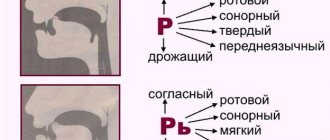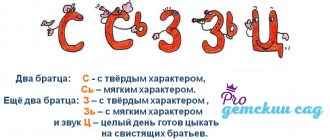Self-analysis of an open individual speech therapy session
Introspection
open individual speech therapy session
Teacher-speech therapist Meleshko N. N.
Subject:
“Automation of the sound “Р”, “Рь” in words, sentences and connected texts.”
The lesson was conducted with a 5-year-old child diagnosed with OHPIII. This event occupies an important place in the system of classes on the topic being studied, and is organized in accordance with a long-term plan for individual correctional and developmental work.
The following goals were set during the lesson:
- Automate the sound “Р” and “Рь” in words, sentences and connected texts using the material of didactic and interactive games.
- Familiarize yourself with the letter “P”.
- Develop phonemic awareness and word sound analysis skills.
- Activate vocabulary on the lexical topic “Clothing”, consolidate knowledge about men's and women's clothing.
- Improve coherent speech by composing common sentences.
- Develop basic mental processes: thinking, memory, attention, using game technologies.
- To form in the child an interest in cooperation and a desire to correct his speech disorder.
To conduct the lesson, didactic material, a lap-book “Sound Box,” was produced, and correctional and educational games were selected.
The goals and objectives set correspond to the content of the lesson. The goals were achieved in unity with correctional and developmental, educational and educational tasks. Solving problems is achieved by various methods and techniques: verbal, visual, practical.
The main stages are built sequentially and are interconnected. There was a transition from one stage to another. Each stage of the lesson prepared the child for subsequent work. The time between each stage of the lesson is distributed expediently, in accordance with the child’s capabilities and the objectives of the lesson. The lesson lasted no more than 20 minutes
All didactic material was selected in accordance with the speech and age characteristics of the child, and is distinguished by its innovation and modernity, which helped to maximally attract and distribute the child’s attention, interest him, and achieve high results in his work. The speech material corresponds to the goals and objectives of the lesson. Practical, visual, and verbal methods of work were used during the lesson. The following didactic principles were taken into account: visualization of learning, awareness and activity of learning, the principle of accessibility of communicated knowledge, differentiated and individual approach. All these principles were implemented in the lesson.
The activation of the child’s mental activity was facilitated by the chosen successful play technique, which permeates all moments of the lesson and makes it a single whole, captures the senses, and generates a desire to cope with obstacles.
The lesson included object pictures, didactic and interactive board games with a correctional focus, and an exercise to develop the sound analysis of words. The speech material was selected taking into account the child’s capabilities, level of speech development, and age characteristics. Work was carried out to develop the skills of sound analysis and synthesis, the formation of case endings of the dative case of nouns, and the enrichment of the active vocabulary with adjectives. Development of coherent speech based on the lexical topic “Clothing”, consolidation of the child’s knowledge about women’s and men’s clothing. Particular attention was paid to the development of basic mental processes: perseverance, visual memory, logical and abstract thinking.
During the lesson, the speech therapist teacher especially monitored the clear pronunciation of words, sentences and coherent texts, tactfully and intelligibly corrected, and asked to repeat correctly.
During the lesson, the child worked actively, showed interest, he really liked the process itself and tried to give the correct answer. But during an exercise to develop phonemic hearing, the girl had difficulty determining the location of the sound “R” in the word “Pinocchio.” The speech therapist helped the child. And the girl, after an explanation, completed the task. The entire session took place in a warm, collaborative atmosphere. It was very intense, a large amount of work was done, the tasks completed showed that the goals of the lesson were achieved. The result was achieved.
Self-analysis of a speech therapy lesson
SELF-ANALYSIS OF Speech Therapy Session
Teacher speech therapist:
Muftakhetdinova Milyausha Rishatovna
Date: 16
.11.2018.
Features of the lesson:
open.
Group of students
: 1st grade, speech therapy conclusion: OHP level 3. Number of students: 6
Lesson form
: frontal.
Lesson topic:
“Automation of the C sound in phrasal speech. Vegetables and fruits".
This lesson is the 2nd in the system of lessons on the section “Whistling sounds”.
When planning this lesson, the following goal was set:
strengthening the skills of correct and clear pronunciation of the sound C in words and phrases.
In the course of achieving this goal, the following tasks were set:
Correctional and educational:
1. Clarify and consolidate knowledge about the position of the organs of articulation when pronouncing the sound [c].
2. Teach clear and correct pronunciation of the sound [c] in words and in phrasal speech.
3. Enrich students’ vocabulary: expand the semantic field, deepen their understanding of the meanings of words.
4. Learn to compose a short descriptive story, coordinating nouns with adjectives in gender, number, and case.
Corrective and developmental:
Development of phonemic hearing, attention and memory, spatial orientation, development of visual perception.
Correctional and educational:
Establishing a trusting relationship between children and the teacher, maintaining interest and a positive emotional attitude towards speech therapy classes.
- Analysis of the purpose and objectives of the lesson.
The topic, goals and objectives of the lesson correspond to the long-term work plan of the group, the speech conclusion, and the level of preparedness of the group. The unity of educational, correctional and educational goals was observed throughout the entire lesson.
Analysis of the structure and organization of the lesson.
The structure of the lesson corresponds to its goals and objectives, as well as the structure of the lesson on dysgraphia. All stages of the lesson are interconnected, a logical sequence of presentation of the material can be traced, and there is also an appropriate distribution of time between the stages of the lesson and the rationality of choosing forms of training. There is aesthetically designed teaching material and equipment.
Analysis of the organization of the educational process of the lesson.
The short duration of the organizational moment, the quick inclusion of all students in the business rhythm of the lesson served as a stimulating introduction to educational activities.
It also created an emotional and business mood and provided the necessary motivation.
The content of the lesson meets the requirements of the program for children with special needs level 3. The presentation of the material being studied was accessible. The connection between the new and the previously studied was traced.
This group of children has poorly developed spatial orientation, which provokes optical dysgraphia. Therefore, the lesson included a task to determine the sides (left-right - up, down).
During the lesson, attention was paid to enriching the vocabulary of adjectives on the lexical topic “vegetables and fruits” and the development of coherent speech (composing a story according to a diagram).
Tasks to find the sound being studied in words and determine its location were given with the goal of developing phonemic perception.
During the lesson, the following mental processes were activated: auditory and visual attention, visual perception, memory.
In order to solve problems in the prevention of dysgraphia at the stage of designating a sound with a letter, independent work was organized in special speech therapy notebooks,
as well as individual work on cards with weak children.
Throughout the lesson, I monitored the clarity and intelligibility of speech.
The children were active and showed interest.
Changing types of activities and physical exercise contributed to the prevention of fatigue and increased attention.
During the lesson, emphasis was placed on the characteristics of sound articulation, since in my experience this contributes to a more meaningful understanding by children of the kinesthetic position of the speech organs, due to which the production and automation of sound occurs faster.
Speech material was selected in accordance with the principle from simple to complex. When consolidating and learning new material, various schemes were used (sound articulation scheme, story composing scheme).
During the lesson, I tried to build a person-oriented interaction with students, listen to each child, and create a situation of success for each of them.
The students successfully completed the tasks, learned to correctly pronounce the sound C in phrasal speech and write a short story.
During the lesson, all problems were solved and goals were achieved.
![Producing the sound [L] to a child in stages. Articulation gymnastics, speech therapy exercises, pronunciation lessons with pictures](https://doktorobrubov.ru/wp-content/uploads/postanovka-zvuka-l-rebenku-poetapno-artikulyacionnaya-gimnastika-logopedicheskie-uprazhneniya-uroki-330x140.jpg)






